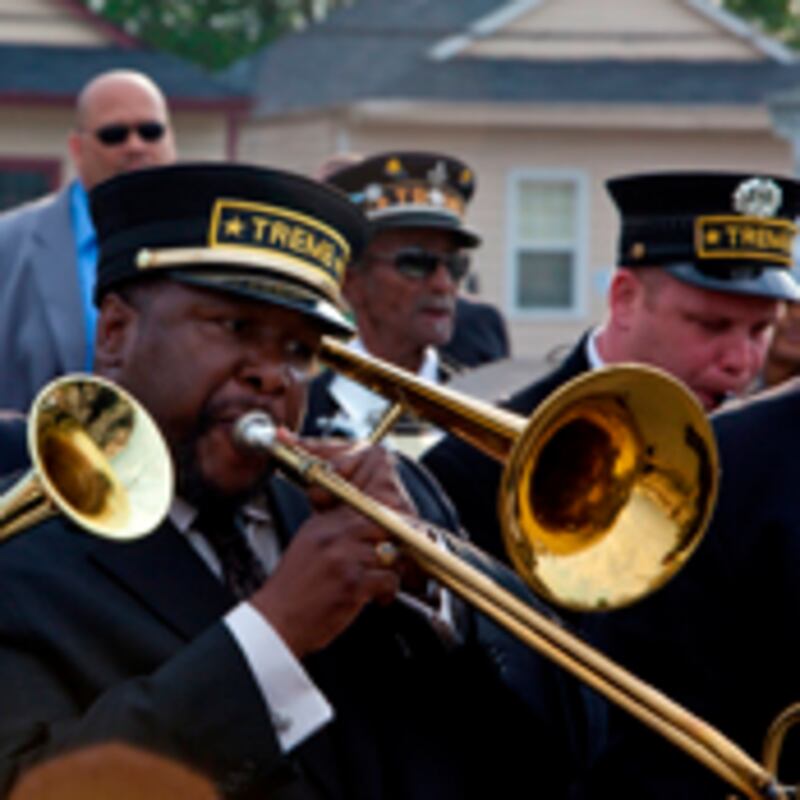
David Simon doesn’t want his new HBO series Treme, a drama about the residents of a New Orleans neighborhood three months after Hurricane Katrina, compared to The Wire.
“It’s not The Wire. It would be insane to try to make The Wire again,” said Simon. “We’re trying to do something different… trying to get at whatever that ineffable thing is that gives a city value as a living experience.”
It’s January and Simon and co-creator Eric Overmyer ( Homicide: Life on the Street) are slouched on a sofa in a crowded bar at the Langham Hotel in Pasadena a few moments before they were slated to appear on a panel for Treme as part of HBO’s Television Critics Association Winter Press Tour session.
“I live among real Americans, and I’m interested in how we’re all going to get along together in this time of diminishing economic health and how we’re all going to find a way to cope with a world of less and where our communal instincts are going to come from,” said Simon.
While Simon and Overmyer look to put some distance between this project and The Wire, the critically acclaimed drama that ran on HBO for five seasons between 2002 and 2008, it’s difficult not to recall the intricate way that Simon wove together stories of cops, drug dealers, street kids, students, teachers, and journalists to create a staggering portrait of post-millennium Baltimore.
Similarly, Treme, which premieres Sunday at 10, sets out to show post-Katrina New Orleans in a way that embodies the tragedies and joys of its residents, as well as a need for those who survived to find the succor to feed their souls. That sense of survival gives Treme both its narrative spine and its gritty realism, as it holds up a magnifying glass to the lives of a neighborhood’s diverse inhabitants, each struggling to find something to grab on to in the wake of upheaval. Bringing their stories to life are such notable actors as Clarke Peters, Wendell Pierce, John Goodman, Melissa Leo, Khandi Alexander, Steve Zahn, Kim Dickens, and Rob Brown, among a cast of hundreds, including real-life New Orleans musicians and locals.
“We have 10 main characters to follow,” said Overmyer. “It’s a small town. They can intersect in some ways. We’re following the individual characters where they lead us. We’re trying to give you a real sense of the city from top to bottom through those people.”
Treme is not easy. There’s the unfamiliar title itself, which refers to a specific culturally significant area of New Orleans, one of the city’s oldest neighborhoods, located just south of the Seventh Ward and west of the French Quarter. (And hint: It’s pronounced treh-may.) Race and the rich sounds of New Orleans jazz provide a significant prism through which Simon and Overmyer explore the tangled lives of this quarter’s residents, but they can also act as obstacles for the audience to overcome. Those with less than an encyclopedic knowledge of the musical genre may find that they need a refresher course on the diverse works of Rebirth Brass Brand, Louis Prima, Elvis Costello, and Jelly Roll Morton.
The subject matter also makes it a tough sell for an audience that may be starting to associate HBO with such high-concept shows like True Blood, Hung, or Bored to Death rather than with the sort of slow-burn intensity the pay cabler’s shows typically had in the past. But Michael Lombardo, HBO’s president of programming and West Coast operations, was quick to play down any questions about whether Treme is more old HBO than new.
“The one thing that the brand continues to be is a place where hopefully we support distinct points of view, distinct voices, and David Simon is that in spades,” said Lombardo, speaking to The Daily Beast a few days before Treme’s launch. “He is a master storyteller who has enormous passion for the stories he tells and the places he takes us. For me, that remains quintessentially the HBO brand… Not every show is intended to appeal to everybody.”
“You don’t embark on a project with David Simon worrying about insularity,” Lombardo continued. “That’s not the journey you take with him; the journey you take with him is to support his vision. He tells you where he wants to go and you support him and you help him realize the vision. We know from experience that we can trust him to execute brilliantly.”
It’s a vision that Simon will be executing without one of his most steadfast and creative collaborators, as co-executive producer David Mills—who had previously worked with Simon on Homicide, The Corner, and The Wire—died from an apparent brain aneurysm on the set less than two weeks before the launch.
A press luncheon originally held in Manhattan last week to celebrate the upcoming launch of Treme instead functioned as a makeshift memorial for the late Mills, whose name pops up all over the early episodes of Treme’s run. “I think if he could have chosen [how to die],” said Overmyer at the luncheon, “he'd die on the set of Treme." Only fitting when dealing with a city as triumphantly vibrant as New Orleans, it was half wake and half celebration. Which is, in some ways, what Treme is about as well.
“We’re trying to tell the story on a human scale,” said Simon. “But, it has to all happen within the context of ordinary people. It’s not a story of mayors and police chiefs. It’s essentially a neighborhood story but we are not limiting ourselves to a specific neighborhood. It’s at that level of people who will encounter the issues of education when the school system returns [and] the issue of crime when crime returns, which didn’t happen right after the storm.”
The initial impetus for Treme’s creation came from Simon and Overmyer’s time on Homicide, when Simon learned that Overmyer lived part-time in New Orleans and they both shared a love for the city’s music. An idea to tell the story of New Orleans through its residents seemed impossible but Simon and Overmyer resurrected the notion during production on Season 4 of The Wire, feeling that Katrina had given their concept a framework on which to hang these interconnected stories.
“I live in Baltimore,” said Simon. “I live among real Americans, and I’m interested in how we’re all going to get along together in this time of diminishing economic health and how we’re all going to find a way to cope with a world of less and where our communal instincts are going to come from. New Orleans, by virtue of the storm, has had that whole question laid bare for them, and watching them try to put back their city, often doing so with some sympathy from the rest of the country and some assistance but also with a lot of indifference from the rest of the country, that’s fascinating.”
The reaction of the media and the general populace is handled directly in the first episode by a character who could be perceived as Simon and Overmyer’s mouthpiece within the narrative, Creighton Bernette, who didn’t originally appear in the pilot script for Treme. Creighton offers an accessible entryway to the story, with a viewpoint that expresses the righteous indignation of a New Orleans resident as well as a human being. Producers cast John Goodman in the role, though HBO was secretive about revealing that Goodman was a series regular on Treme until just before the pilot was screened for the press.
“The character was always planned,” said Simon. “Originally, we were going to come home with Toni Bernette [Melissa Leo] and meet the family in Episode 2, just for space reasons. And, indeed, the reason we probably have a longer pilot is we decided we really needed to address that character... We decided to move the scenes up from Episode 2, but we were looking to cast, and we thought about John Goodman right away.”
Goodman, himself a New Orleans resident, plays Creighton, a Tulane University professor of English literature and an outspoken critic of the way that the aftermath of Katrina was handled by the local and federal governments. He is loosely based on the late New Orleans professor and blogger Ashley Morris, who passed away two years ago.
“It gave us an organic, passionate way to editorialize and to be political about the city—in a bigger way—that would have been false for any of the other characters,” said Overmyer. “Because he’s a Tulane professor and because he’s one of those people who came to New Orleans—he’s not a native—[but] a convert, and converts are often more passionate in their defense of their city or their religion than the native-born.”
HBO’s Lombardo said HBO had nothing to do with Goodman’s Creighton being moved into the pilot episode. “[Creighton] plays the role of a sort of Greek chorus of reminding all of us in a larger, macro sense of what was at stake with New Orleans and Katrina,” he said. “This, again, was David and Eric looking at the pilot and feeling that that was a piece that needed to be added. I’d like to take some credit but it’s just not correct. It’s solely the handiwork and the minds of David and Eric.”
Regardless of who came up with the idea to include Goodman’s character, he offers a specific—and fiery—viewpoint about whether New Orleans will survive the storm and who is to blame for the aftereffects of Katrina, which leads to the relocation of many of its residents. Ultimately, Treme is about whether or not New Orleans is able to resurrect itself. “You hear it in the pilot with, ‘You home yet? You coming home? When do you get home?’” Simon said. “There’s a lot of Diaspora in the first season, and dislocation.”
“People are unbelievably attached to New Orleans through generations,” said Overmyer. “It’s a big deal to leave New Orleans. It’s a big deal to be away.”
That element of Diaspora colors every conversation that Treme’s characters have with one another, with most of them greeting each other with a question about the state of their homes.
“’How’s your house?’ ‘Are you back?’” said Overmyer. “There’s actually a T-shirt: Don’t ask me about my fucking house.”
Jace Lacob is the writer/editor of Televisionary, a Web site devoted to television news, criticism, and interviews. Jace resides in Los Angeles. He is a contributor to several entertainment Web sites and can be found on Twitter and Facebook.






